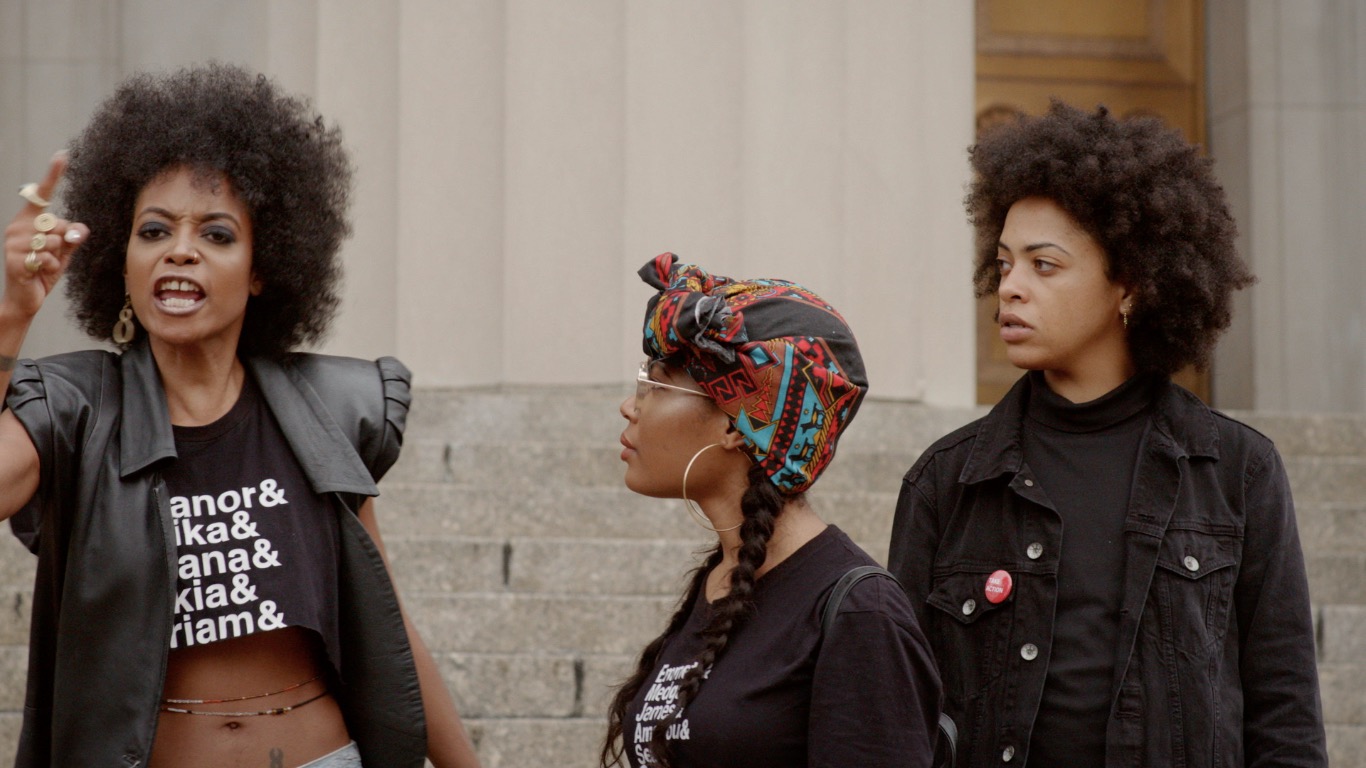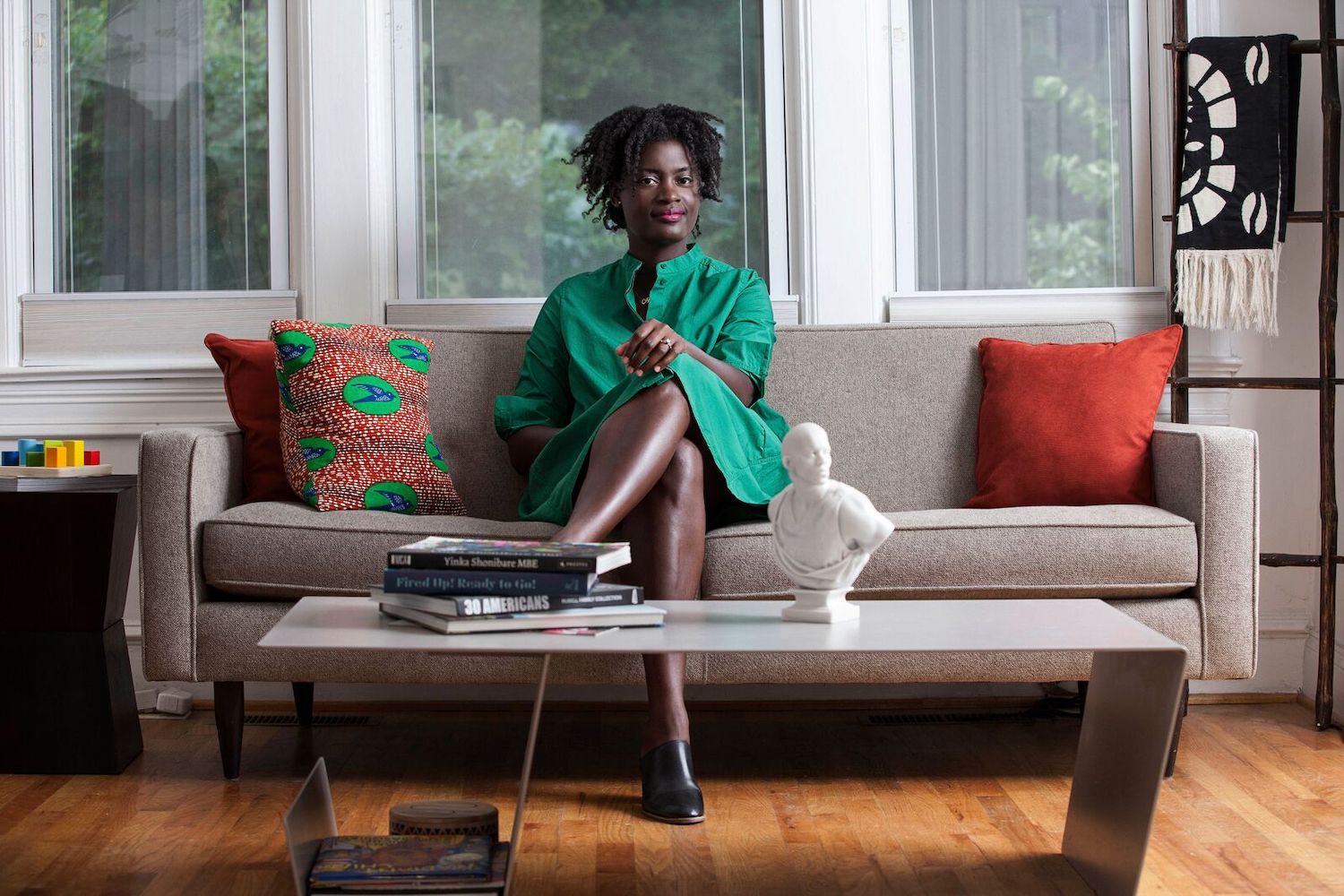This week: Continuations of coming out at Terrault Gallery, resilience and resistance at Creative Alliance, and musical-visual collaborations at Current Space.
The Friday Gallery Roundup is a curated compilation of three short reviews of three current exhibitions worth your time and consideration. There’s much to see and do in this town every day—check out our calendar and weekly picks for even more options—but here’s a list of shows you can check out now.

Elliot Doughtie, “My Head Has Less Volume Than My Thighs,” copper pipe, copper couplings, epoxy, enamel, plaster, glass vial, oil, testosterone, tile, ftm masturbator, steel, rebar, plastic (2019). Background: “With Teeth,” tile, joint compound, enamel, fox teeth on board (2019) and “Dose,” copper pipe, glass vial, cottonseed oil, testosterone (2018)
Become Again, through May 18
Terrault, 218 W. Saratoga St., 3rd Floor, Baltimore, 21201
Gallery hours: Saturday 1–5 p.m. and by appointment
Closing reception and artist talks: May 16, 7–10 p.m.
As I step further into the gallery nook-cum-deconstructed bathroom, a red light snaps on. Behind me, a long copper pipe emerges from a mint green tile ground and aspires to reach the ceiling. A marbled sleeve grips the pipe almost all the way up and around it, like a synthetic skin, wrinkled presumably by hand with a repetitive grasping motion. The rest of Elliot Doughtie’s sculptural installation “My Head Has Less Volume Than My Thighs” comprises bathroom signifiers—pipes, tiles, spigots, what looks like a stand-to-pee device—that become a setting for other signifiers of gender and sexual identity (and the exploration of those), like FTM masturbators and tiny vials of testosterone. Assembled into analytical, delicate contraptions, the installation projects the bathroom as a site for possible pleasures, fear, affirmation, but also a site that is never neutral.
Multiplicities abound in Become Again, curated by Jared Christensen, shrugging off any singular, encapsulating moment of “coming out,” in favor of nuance and fluidity and the idea that coming out is a recurring process. And while Terrault Gallery’s size forces an intimate interaction with the works by four artists, it feels like the show’s about to burst out of the relatively small space.
Among Doughtie’s exploratory objects hang framed illustrations by Jasjyot Singh Hans, featuring too-fabulous fashion models of all sizes in couture that also manages to reference elements of the bathroom without being crass. A spigot-shaped hat on the head of a long-haired lady seems to drip out her gemstone-fishnet garment, like the one Rihanna wore but somehow seemingly richer.
Mandy Chesney’s glitter and acrylic on mylar chamber, into which you wander and let the light and subtle rainbows shine onto you through lacelike designs, is exuberant, like so many sorts of bodily secretions. And Nick Simko’s quieter photos bring back a calm sensitivity, yet still echoing the other artists’ toying with visibility. In “Vanishing Act,” a person is backlit by the horizontal stripes of window blinds and shrouded in thin layers of silky sheer fabric, which they raise up so it covers their face and body. The bands of white from behind pour through onto the pleated fabric, disappearing this body with a mutable mess of shapes of shadow and light.

Nick Simko, “Vanishing Act,” inkjet print (2019)

McKinley Wallace III, “Intersection,” acrylic, charcoal, ink, print on wood panel, 2018
Respond Under Blue, through May 25
Creative Alliance, 3134 Eastern Ave., Baltimore, 21224
Gallery Hours: Tuesday–Saturday, 11 a.m.–7 p.m.
McKinley Wallace III makes the most of the scuffed-up and wire-crossed walls and brick storefronts that serve as indicators of urban living in his mixed-media drawings. It’s easy to get sucked into the exacting way he represents the play of light and shadow across these exteriors and forms. But there is also the utterly unignorable thin blue line in many of his otherwise black-and-white compositions to contend with. Understood in most scenes as a piece of the sky, the blue line has a stifling effect, and acts as a kind of lid for several of Wallace’s pieces, which gesture at and rebuke state oppression of Black people.
In his piece “Intersection,” Wallace trims away almost all the ambient visual noise of brick and wires and busted cars that appear in other scenes, distilling the city experience into this big-empty confrontation with police. The piece is composed like a more-crisp Rothko, a scuffed-up grey rectangle forms the backdrop for a tiny reproduction of the famous image of activist Gloria Richardson pushing past a National Guardsman’s bayonet in a 1963 Cambridge, MD protest. A deep black frame isolates the scene; an inch or two of dark blue sky appears up top—and an eerie eye emerges from the depth of black, sulking over the scene as if from a tinted car window. Who’s that passive, white observer?
Wallace works best in these areas of subtlety. I spent some time going back and forth with “Beware Fences,” a small panel with a billboard-shaped rectangle of black that hovers above a spiny fence. The black rectangle is modulated with barely lighter shades and a splatter of glossy medium in which at first I saw a flash of gritted teeth and then, having moved, nothing I could name. The blue line crops up again, yearning for attention, though it’s here where I could almost imagine it being pushed all the way up and out of the scene, with enough force.

Elena Johnston and William Cashion, #9, gouache on wood panel, 16″ x 20″ (2018)
Pinta Manta, through June 1
Current Space, 421 N. Howard St., Baltimore 21201
Gallery Hours: Fridays and Saturdays, noon–4 p.m.
Some artists can’t listen to music or anything at all when they make their work, fearful of the sounds’ influence on their work or mark-making, but for artists Elena Johnston and William Cashion (best known for his music in Future Islands and Peals), sonic influences are what their collaborative paintings are all about. In Pinta Manta, canvases are playfully and rhythmically daubed with pastels, earthtones, and even occasional neons, little electrifying bursts that somehow cohere with the rest. It takes a bit of perusing to realize that the two halves of a canvas form almost-kinda-sorta mirror images of each other, horizontally and vertically and sometimes diagonally, too.
With a canvas laid out on a table between them, Johnston and Cashion paint simultaneously while listening to specific playlists, making marks with paint and trying to copy each other’s maneuvers. Some of these paintings project a calm and considered energy, while others explode into a chaotic board game, making it appear that their attempt to mirror one another’s actions was not a choreography, but simply more of a goal.
The title of the show (and the series) takes its name from a 1983 song by Cape Verdean musician António Sanches. According to the wall text, Cashion and Johnston listened to that song on repeat, along with playlists full of Latin American and West African electronic and pop music. Their process was both improvisational and predetermined, and the structures they designed and followed stay mostly hidden to the viewer who walks around the gallery, eyeballing the finished paintings. But because these rules and processes were so intentional, as a viewer I’d have liked to see some hints to them aside from what the wall text gestures at, even if it were just a sample playlist or two that I could check out and try to match sounds to brushstrokes.

Elena Johnston and William Cashion, #15, gouache on wood panel, 18″ x 18″ (2019)
Photos taken by author






